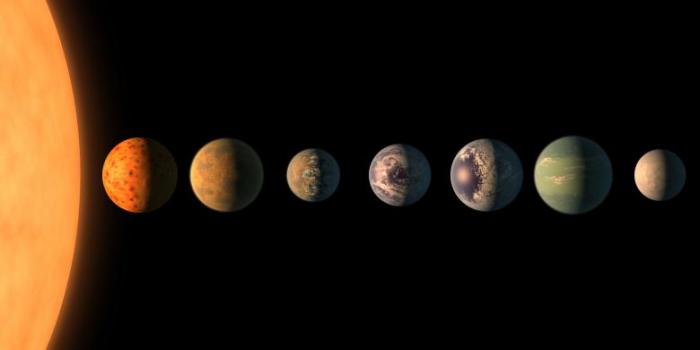Alien Life Unlikely in TRAPPIST-1 System, NASA Hyping Findings for More Funding, Christian Astrophysicist Hugh Ross Says

The discovery of seven Earth-sized planets orbiting a single star has sparked major excitement among some scientists looking at the possibility of life existing outside of Earth, but one Christian astrophysicist has warned that the chances of these planets being habitable are small, and that Earth's uniqueness is proven again.
The seven planets in question were found orbiting the TRAPPIST-1 ultracool dwarf star close to 40 light-years, or 235 trillion miles, away from Earth, with NASA suggesting that all seven could potentially have liquid water, with three of the planets in particular existing in a habitable zone that could, given the right conditions, sustain life.
"This discovery could be a significant piece in the puzzle of finding habitable environments, places that are conducive to life," said Thomas Zurbuchen, associate administrator of the agency's Science Mission Directorate in Washington.
"Answering the question 'are we alone' is a top science priority and finding so many planets like these for the first time in the habitable zone is a remarkable step forward toward that goal."
Astronomer and best-selling author Dr. Hugh Ross told The Christian Post in a phone interview on Thursday, however, that the peer-reviewed article in the British science journal Nature, which detailed the findings, is actually quite subdued about the discovery.
Ross, who has written numerous works exploring just how special and unique Earth is when it comes to sustaining life, including his latest book, Improbable Planet: How Earth Became Humanity's Home, pointed out that the talk of alien life is coming mostly from NASA's announcement and various web articles.

"I think that NASA is looking for funding, so I think they are actually hyping it a little more than they should," Ross told CP.
As the astrophysicist also explained in an article on his ministry website, Reasons to Believe, what is important to know is that the seven planets, albeit similar in size to Earth, are orbiting an "extremely small star."
"The luminosity of the star is less than a thousandth that of the Sun," he said.
"Ultracool, fast-rotating stars exhibit frequent huge flares that are accompanied by strong x-ray and ultraviolet radiation," Ross pointed out.
"The XMM-Newton x-ray space telescope has confirmed that the planets orbiting TRAPPIST-1 that reside in the liquid water habitable zone are exposed to sufficient x-ray and ultraviolet radiation from TRAPPIST-1 to significantly chemically alter and erode their primary and secondary atmospheres."
What is more, given that the planets are orbiting very close to their star, it suggests that they are tidally locked — meaning that "one side of the planet will always be facing the star, while the other side will be in perpetual darkness," he continued.
The astronomer said that if any water is to be found on the newly discovered planets, it will have to be at the "twilight zone — the edge between perpetual light and perpetual darkness."
Ross said that the continued discoveries of new planets that at first seem like they could have the potential to be habitable, but on closer examination are shown to be lacking the conditions needed to truly support life, proves just how special the Earth is.
"I think it's actually going the other way, in the sense that the more planets they discover, and the more we learn about them, the more we recognize how unique our own planetary system is, and its capacity to support life."
As he elaborates in another article on Reasons to Believe, ever since the discovery of the first of such exoplanets was made 20 years ago, researchers have not only failed to find an "Earth twin," they haven't even found a twin of the other planets in the solar system.
"Every one of our eight planets makes life on Earth possible, we need every one of them the way they are. We are not seeing that planetary configuration anywhere else. All the focus has been on the water habitable zone, and that's the widest of all zones for habitability, but because of research on these other planets, we now know there are at least nine truly habitable zones," he continued, arguing that in order for life to exist, it must reside in all nine of these zones at the same time.
"Of all the planets we have discovered, over 3,600, there is only one that resides in all nine habitable zones, and that's the planet you and I are sitting on," the astrophysicist said.
As for whether God created life on any other planets, a question he has tackled throughout his career, including in a November 2016 CP interview, Ross offered that from a Christian perspective, there are a few different options to go with:
"God seems to enjoy creating so much, what is to stop Him for creating life on another planet? He would have had to miraculously design it, just like He did our planet. That's within the realm of Evangelical Christian thought," he said of one way of thinking.
"But it's also within the realm of Evangelical Christian thought that we are alone. God doesn't seem to waste His miracles, and if all He needs is one planet to carry out His redemptive plan for designing the universe the way He did, then we would expect to be alone."
Ross said that ultimately it is a "healthy debate," because either way, the question "has no impact on the doctrines of Salvation."
Finally, Ross highlighted that he has been on record since the 1980s predicting that the remains of life will be found on the moon and other bodies within the solar system, given that tons of the Earth's soil have been exported outside the planet, due to meteorites.
The moon, he positioned, could hold the fossils for the earliest life on Earth, which are not present on our planet, since Earth's geology has destroyed them.
"We can go to the moon, and solve the origin of life enigma — was life natural, or was life a supernatural event?" he said.




























